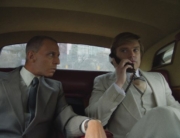The Heart of Bruno Wizard opens circa 2004 with Bruno performing his first London concert since 1986. In his element, Bruno commands the stage, ever the rock star. His youthful spirit, formed in the British punk scene, remains undimmed.
Elisabeth Rasmussen’s documentary resurrects the anarchic London underground scene of the 1970s through interviews and archive footage. Andrew Czezowski and Susan Carrington, co-founders of the punk venue the Roxy, set the anti-establishment scene. Formed out of necessity to provide a stage for the bands that Czezowski managed, the London club was a platform for bands from the Jam to Generation X. Its original resident DJ, Don Letts, sheds light on the groups that shaped the scene, such as Bruno’s early band the Rejects.
As an untrained musician, Bruno embraced punk, but became frustrated when the scene was absorbed by the mainstream music industry. As a reaction, he changed his band’s name to the Homosexuals to deter any interest from a mainstream record label. The Homosexuals sound developed with angular guitars, complex melodies, and experimentation that distanced them from their contemporaries and gained them a reputation as a precursor to post-punk.
In 1978, London’s infamous Warren Street squat was set up. Bruno took up residence and joined creative minds like artist Leigh Bowery, dancer Michael Clark, milliner extraordinaire Stephen Jones, and singers Boy George and Marilyn. The latter two would eventually become among the biggest cultural influencers of the ’80s. Jones and Marilyn recall the breadth of Bruno’s creativity, and his chemical dependency. When a prison stretch forces Bruno to get clean, he is reincarnated on his release and later becomes a fashion agent, championing the work of ’80s British designers in New York.
Rasmussen met Bruno in 2012 when he was a temporary resident at a London hostel for the homeless, where she volunteered over Christmas. When Bruno’s personal struggle to escape homelessness takes the foreground, the narrative is more focused. Simultaneously diagnosed with a serious health condition, he accepts adversity graciously and emerges as an amiable rolling stone. And while his only certainty is his anti-establishment credentials, he continues to passionately champion young designers and fight for causes, including the release of the imprisoned Russian provocateurs Pussy Riot.
Rasmussen’s affection for her subject is clear, and they obviously have developed a close relationship—she is the first person Bruno calls when his medical results come through. He is still charismatic at a challenging time in his life, but the focus leaves some stones unturned and questions hanging in the air, such as his criminal convictions and love life. Regardless, there’s plenty to like about Wizard. Rasmussen offers an appreciation of his continuing life struggle to stay true to himself, and where others of his generation have conformed, Bruno continues to fight on.







Leave A Comment